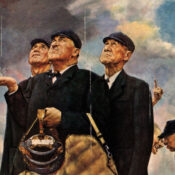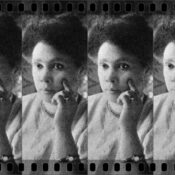Imagine unearthing a Picasso in the corner of your basement, perfectly preserved for decades before you finally uncover it. Roy E. Disney experienced this in 1999 when he stumbled across Destino, the 1946 collaboration between his uncle Walt Disney, the animation pioneer, and Salvador Dalí, Spain’s legendary surrealist painter. And his decision to revive the project left us one of the most interesting collaborations in animated film history.
How many stars had to align before Disney’s creativity and Dalí’s imagination finally came together? It turns out, all they really needed was a dinner party hosted by Jack Warner (of Warner Bros. Studios). Walt Disney had caught the surrealism “bug” while creating Fantasia, and with it came the desire to continue dabbling in projects that carried the same dreamy element. Similarly, Dalí had a newfound fascination with cinematography and was determined to become the first popular surrealist to invade the film industry.
The story of their initial meeting has been passed around like folklore. It could only be verified through John Hench’s recollections and Jack Warner’s guest list. As the legend goes, at Warner’s party, Dalí and Disney immediately connected, and an overjoyed Dalí accepted Disney’s proposal to collaborate on a surrealist animated short. Over the next eight months, they created more than 200 storyboard sketches set to a love ballad composed by Fantasia composer Armando Dominguez. Their paired ambition (along with John Hench’s tremendous draftsmanship) resulted in the story of a haunting romance between two star-crossed lovers: Dahlia, a mortal woman struggling to find love, and Chronos, an all-powerful titan and the personification of time itself.
Sadly, financial struggles after World War II forced the studio to place the project on an indefinite hiatus. Destino spent the next five decades hidden in the Disney archives.
Destino was a project shared between two great artists at the peak of their powers. Dalí and Disney strove to bring people out of their daily tedium into what they considered better, more imaginative worlds. In their six-and-a-half-minute film, objects around Dahlia break or melt away as she dances her way through the scenery. She moves in and out of landscapes like a trapeze artist while her large, longing eyes scan the terrain for her lover. Her body undergoes drastic transformations — taking the shape of a bell tower, a dandelion, a ballerina, and a baseball — all in hopes of finding a form that can coincide with Chronos’s immortality. In turn, Chronos tries to meet her efforts by breaking free from his bonds.
But large towers prevent them from reaching each other. It takes a variety of surreal movements and shifting scenery before Dahlia’s bell tower appears in the hole in Chronos’s heart, signifying that the two have finally become one.
It took nearly 60 years for Destino to finally be completed — 37 years after Walt Disney’s death and 13 years after Dalí’s. By the time the artwork was rediscovered, nearly 50 original sketches had been lost or damaged due to poor preservation. Roy Disney re-recruited John Hench to help revive the project in 2002, and together, they stitched the remaining sketches into a single piece, keeping as close to the original storyboard as they could. Fans of Disney and Dalí will find that both artists’ styles are clearly evident throughout the film.
The final product was released on June 2, 2003, at the Annecy International Animation Film Festival. It was nominated for the Academy Award for Best Animated Short Film and honored in multiple exhibitions. It won titles in the Chicago, Rhode Island, and Melbourne International Film Festivals and even inspired its own four-star resort in Talamanca, Spain.
Disney and Dalí got more than what they bargained for out of their partnership. The Destino collaboration led to a lifelong friendship between the man behind the mouse and the painter of melted clocks. It’s more than just a surrealist 1946 package film. It’s a melding of the styles of two of the 20th century’s most imaginative minds.
Become a Saturday Evening Post member and enjoy unlimited access. Subscribe now


